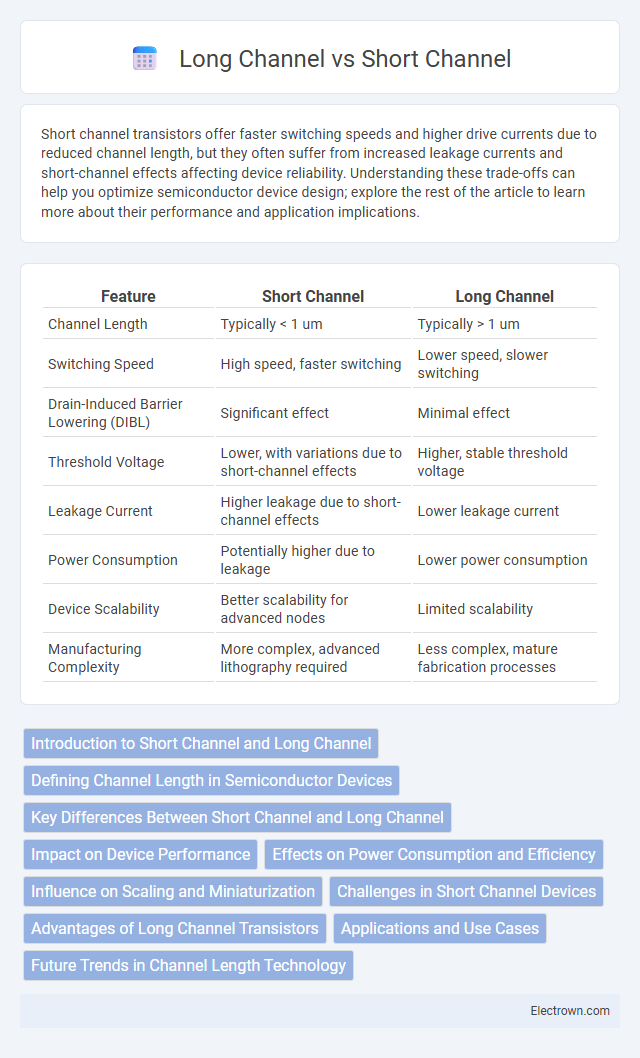Short channel transistors offer faster switching speeds and higher drive currents due to reduced channel length, but they often suffer from increased leakage currents and short-channel effects affecting device reliability. Understanding these trade-offs can help you optimize semiconductor device design; explore the rest of the article to learn more about their performance and application implications.
Table of Comparison
| Feature | Short Channel | Long Channel |
|---|---|---|
| Channel Length | Typically < 1 um | Typically > 1 um |
| Switching Speed | High speed, faster switching | Lower speed, slower switching |
| Drain-Induced Barrier Lowering (DIBL) | Significant effect | Minimal effect |
| Threshold Voltage | Lower, with variations due to short-channel effects | Higher, stable threshold voltage |
| Leakage Current | Higher leakage due to short-channel effects | Lower leakage current |
| Power Consumption | Potentially higher due to leakage | Lower power consumption |
| Device Scalability | Better scalability for advanced nodes | Limited scalability |
| Manufacturing Complexity | More complex, advanced lithography required | Less complex, mature fabrication processes |
Introduction to Short Channel and Long Channel
Short channel devices feature channel lengths typically below 1 micron, enabling faster switching speeds and higher integration density in modern CMOS technology. Long channel devices have channel lengths greater than a micron, offering better control over short-channel effects and improved device reliability. The choice between short and long channel impacts performance parameters such as drive current, leakage current, and threshold voltage stability in semiconductor design.
Defining Channel Length in Semiconductor Devices
Channel length in semiconductor devices refers to the distance between the source and drain regions within a transistor, crucially influencing its electrical characteristics. Short channel devices, typically under 100 nanometers, offer faster switching speeds but face challenges like increased leakage currents and short-channel effects. Long channel devices, generally above a few hundred nanometers, provide better control over these effects but operate at slower speeds, making the choice dependent on your specific performance and power requirements.
Key Differences Between Short Channel and Long Channel
Short channel transistors feature channel lengths typically below 1 micrometer, resulting in higher electron velocity and increased drive current but also enhanced short-channel effects like velocity saturation and drain-induced barrier lowering (DIBL). Long channel transistors have channel lengths greater than several micrometers, offering better control over threshold voltage and reduced leakage currents, but slower switching speeds due to lower electron mobility. Your choice between short and long channel devices depends on the trade-off between high-speed performance and device reliability in semiconductor design.
Impact on Device Performance
Short channel devices enhance switching speed and drive current due to reduced channel length but often face increased short-channel effects like threshold voltage roll-off and drain-induced barrier lowering, which can degrade device reliability. Long channel devices offer better control over channel conduction and exhibit lower leakage currents, resulting in improved stability and reduced short-channel effects but at the cost of slower operation speeds. Your choice of channel length directly influences the trade-off between device speed and reliability, crucial for optimized semiconductor performance.
Effects on Power Consumption and Efficiency
Short channel transistors exhibit lower resistance and faster switching speeds, reducing power consumption and enhancing efficiency in high-speed circuits. Long channel devices generally have higher threshold voltages and lower leakage currents, which can improve power efficiency in low-frequency or standby modes. Understanding these trade-offs helps optimize Your circuit design for either high-performance or low-power applications.
Influence on Scaling and Miniaturization
Short channel transistors exhibit increased electric field effects, leading to challenges like velocity saturation and drain-induced barrier lowering that impact device scaling and performance at nanoscale dimensions. Long channel devices offer better control over channel conduction and reduced short-channel effects but limit miniaturization due to larger physical size. Scaling trends favor short channel designs for higher integration density, yet require advanced techniques like strain engineering and high-k dielectrics to mitigate degradation and maintain device reliability.
Challenges in Short Channel Devices
Short channel devices face significant challenges such as increased leakage current, short channel effects (SCE), and threshold voltage roll-off, which degrade overall transistor performance and reliability. Managing these issues requires advanced techniques like channel doping optimization, high-k dielectrics, and strained silicon to maintain control over the channel. Your device scaling efforts must carefully address these challenges to ensure stability and efficiency in modern semiconductor technologies.
Advantages of Long Channel Transistors
Long channel transistors offer superior control over short-channel effects, resulting in enhanced device reliability and reduced leakage currents. Their larger channel length improves threshold voltage stability and minimizes hot carrier degradation, which benefits circuit longevity and performance. Your designs can achieve higher precision and lower power consumption by leveraging these advantages in analog and low-frequency digital applications.
Applications and Use Cases
Short channel devices excel in high-speed and high-frequency applications such as advanced microprocessors and RF circuits due to their reduced channel length, which allows faster switching and improved drive current. Long channel transistors are favored in analog circuits, sensors, and low-power applications where better control over short-channel effects and reduced leakage currents are critical for stability and precision. Both channel lengths have distinct advantages, with short channel devices driving performance-intensive technology and long channel transistors ensuring reliability in precision and low-power designs.
Future Trends in Channel Length Technology
Emerging trends in channel length technology emphasize the transition towards ultra-short channel designs below 5 nanometers to enhance transistor speed and energy efficiency. Research in novel materials like 2D semiconductors, such as graphene and transition metal dichalcogenides, aims to overcome short-channel effects and improve scalability beyond traditional silicon-based long channels. Advanced fabrication techniques including extreme ultraviolet lithography (EUV) and gate-all-around (GAA) architectures are critical for achieving precise control and leakage reduction in future nanoscale channels.
Short channel vs Long channel Infographic

 electrown.com
electrown.com